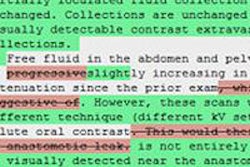Quality assurance (QA) for imaging study acquisition can be a little challenging in the PACS era, but a Web-based reporting system for facilitating feedback between radiologists and technologists can get meaningful results, according to research published in the August issue of the American Journal of Roentgenology.
Massachusetts General Hospital (MGH) transitioned from a paper index-card image QA reporting model to a Web-based and PACS-integrated reporting system and saw a significant decline in three common image quality errors, according to a team led by Dr. Gregory Czuczman.
"After implementation of the prototype and, subsequently, the department-wide Web-based image quality assurance reporting systems, we showed that error rates significantly decreased over the transition period," the authors wrote (AJR, August 2013, Vol. 201:2, pp. 361-368).
No feedback loop
With PACS, it's not unusual for technologists to acquire and manage data without receiving sufficient feedback, and for radiologists to interpret studies remotely without providing feedback on image quality, according to the researchers.
"This lack of communication results in technologists performing their duties in parallel as though they are unrelated tasks," the authors wrote. "Radiology departments are now faced with the task of efficiently addressing the quality of imaging performed over multiple, sometimes widely separated, clinical sites."
At MGH, radiologists traditionally reported image quality errors on green index cards, which were then placed in bins in reading rooms throughout the radiology department to be collected periodically by site managers and addressed with technologists. This approach was grossly underutilized, however, according to the researchers.
To improve the situation, senior author Dr. Ambrose Huang developed a prototype Web-based image QA system, written in HTML and version 5.10 of the Perl programming language. Automatic population of report fields was performed using version 1.0 of the AutoHotkey open-source utility (developed by Chris Mallet).
The software was deployed within the department's division of musculoskeletal imaging and intervention between April 2009 and December 2010. Because it's Web-based, the system allows radiologists to generate electronic trouble tickets from any workstation while dictating a radiology report, according to the researchers.
"The radiologist needed only to identify the imaging resource on which the examination was performed, categorize the image quality problem using a pull-down menu, and type in additional details if necessary, all with minimal impact to workflow," the authors wrote. "The system would email the submitted trouble tickets to the technical manager responsible for overseeing the imaging resource on which the examination was performed and enter the ticket into a database for longitudinal tracking."
Common image quality errors
Prior to implementing the system in April 2009, the researchers assessed three common image quality end points (axillary shoulder orientation errors on radiographs, coronal and sagittal reformatting errors on CT, and sacral MRI sequence errors) immediately before deployment of a prototype system, approximately 18 months after deployment, and then 18 months after installation of an upgraded department-wide reporting system in January 2011.
The new, upgraded system is written in version 2.3 of the Ruby on Rails open-source Web framework, and trouble tickets are stored in a structured query language (SQL) database. It's also integrated with the institution's PACS and HIS and features a loop closure mechanism, according to the team.
Overall, a total of 3,067 axillary shoulder radiographs were reviewed over the course of the study for correct orientation, while 355 shoulder CTs were reviewed for correct reformatting of coronal and sagittal images. In addition, 346 sacral MRIs were reviewed for correct acquisition plane of axial images.
| Image quality error rates | |||
| Prior to deployment of Web-based QA system | 18 months after deployment of prototype | 18 months after installation of upgraded department-wide system | |
| Axillary shoulder orientation errors | 35.9% | 7.2% | 10% |
| Shoulder CT reformatting errors | 9.8% | 2.7% | 5.8% |
| Sacral MRI axial sequence errors | 96.5% | 32.5% | 3.4% |
The decrease in errors between the first and second periods was statistically significant for axillary shoulder orientation errors (p < 0.0001), shoulder CT formatting errors (p = 0.03), and sacral MRI errors (p < 0.0001). In addition, the decline in sacral MRI axial sequence errors was also significant from the second to third periods (p < 0.0001).
Unexpected errors
The increase in axillary shoulder orientation errors in the third period was unexpected, leading the researchers to further categorize errors by the site at which they were performed. Czuczman and colleagues then discovered "remarkably high" error rates at two new remote radiography imaging sites that had been added to the department during the third period.
Excluding errors from those two sites, the error rate would have dropped to 6.6%, which was not statistically significant as compared to the second period, according to the group.
At the time the paper was submitted to AJR, the integrated image QA reporting system had been used for 7,724 submission tickets over 22 months, the authors reported.
"Although composite data for the index-card-based system previously used at our institution are not available, we have experienced a marked increase in the number of image quality submissions according to reports from site managers, technologists, and radiologists," they wrote. "We think, similarly to previous authors, that this increase does not reflect a deterioration of quality but rather is at least in part a result of reporting events that were not previously reported or were dealt with in other ways."
While the system has not eliminated all errors, it has led to measurable improvements in image quality that have been sustained over time, the researchers noted.
"With a combination of continued increased utilization, targeted education initiatives in deficient areas, and continuing to achieve a culture of quality, we think that further improvements will be forthcoming," they wrote.



















